Point-and-Figure Charting in Forex
Contents
What is point-and-figure?
At first, such charts may seem strange and alien to a currency trader, but
To start drawing a P&F chart, first, it is necessary to decide the box size — the price change that would be big enough to draw as either X or O on the chart. Usually, the box size is chosen as 10 pips in Forex trading. Of course, any box size can be used — 6, 50, 100, or even 1,000 pips. The bigger the box size is the more filtered the P&F chart will be and the less movements it will contain. The smaller the box is the less filtered becomes the price and the more price movements get pictured on the chart.
Once the size of the box is chosen and the starting point is decided, the drawing can be started. When the price goes up 10 pips up (let us consider the box size = 10) an X can be drawn on the chart. When the price goes up another 10 pips, a new X is drawn on top of the first one and so on. If the price fluctuates within 10 pips, nothing is drawn on the chart. As you see, the filtering power of the method is obvious. To draw a bearish movement, it would be necessary to put an O for every 10 pips that the price goes down.
In addition to the box size, another important parameter is chosen by a trader — reversal size. The reversal size is the number of boxes that the price has to go against the current movement to end it and to start drawing a new one in the opposite direction. The reversal size of 3 and 4 is quite common but any integer number equal to or greater than 1 can be chosen as the reversal size.
Let us consider the reversal size = 3. If the bullish movement (a column of ascending X's) is currently being drawn, then to qualify for a reversal, the price has to go down
The process continues ad infinitum. As a result, a trader sees a lot of X's and O's plotted on the chart — they represent the price changes in pure form and can still be analyzed with the conventional technical analysis tools, for example — chart patterns. You can scroll down to see several examples of P&F charts plotted in various pieces of FX trading software.
Software for P&F charting
Non-MetaTrader solutions
FXCM is a Forex broker that offers its own point-and-figure charting solution — via a proprietary Trading Station 2.0 desktop platform. The PnF view can be customized via box size and reversal values. Unfortunately, it doesn't support dynamic (e.g., ATR-based) box size setting. A point-and-figure view can be enabled via the platform's Marketscope 2.0 extension:
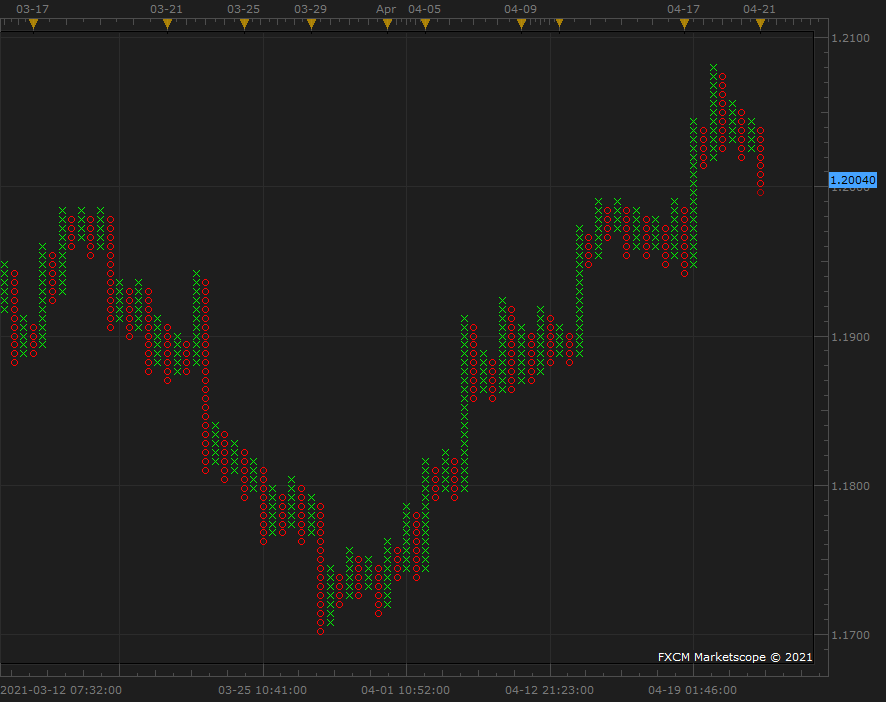
TradingView offers by the most functional and easy-to-use point-and-figure charting method. Not only it allows customization of every parameter, it also supports dynamic box size based on the ATR indicator:
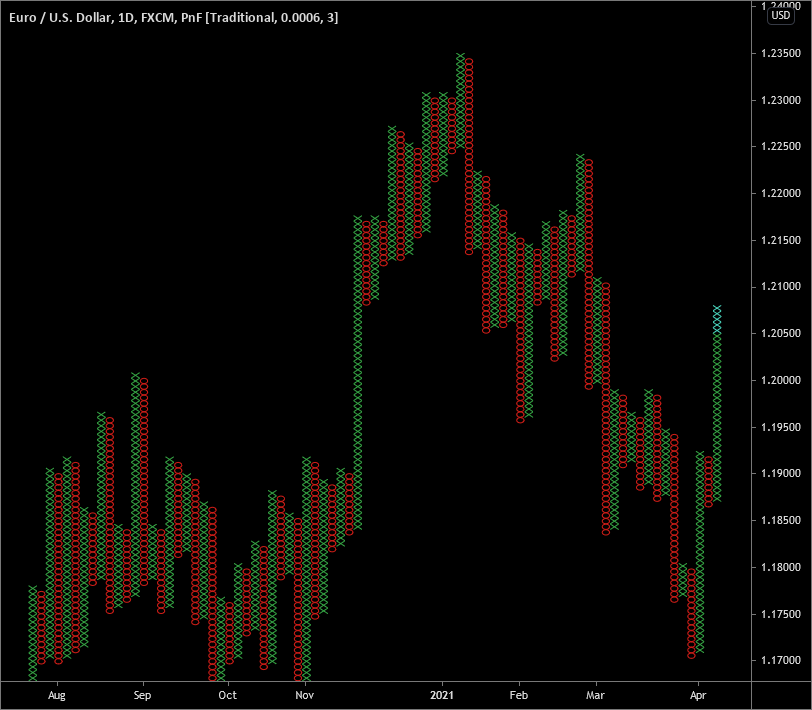
MetaTrader solutions
MT4
Here is an overview of several free P&F charting indicators for MetaTrader 4.
Cute Point & Figure Indicator v.1.1 — a free version of the paid indicator with the same name. Comes with four different MetaTrader templates and can be quite tricky to set up. Once set up, offers a rather nice layout of X's and O's or boxes directly in the main chart window, with dates, months and years marked directly on the chart — very handy. The chart settings can be adjusted to the smallest details. The main drawback — calculation is very slow and can freeze a trading terminal. Oh, and the source code is not available for tweaking.
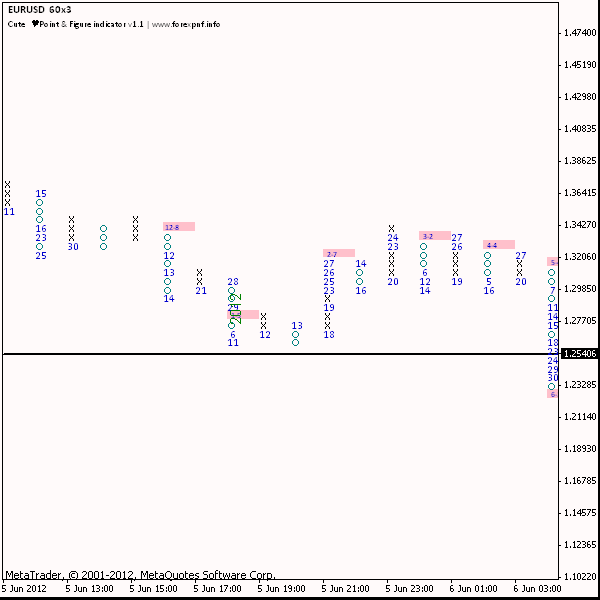
FXI Point and Figure by Forex Impact — not only it is a fully customizable and very fast P&F indicator, it also shows the trend lines for the price movements and gives signals according to the common
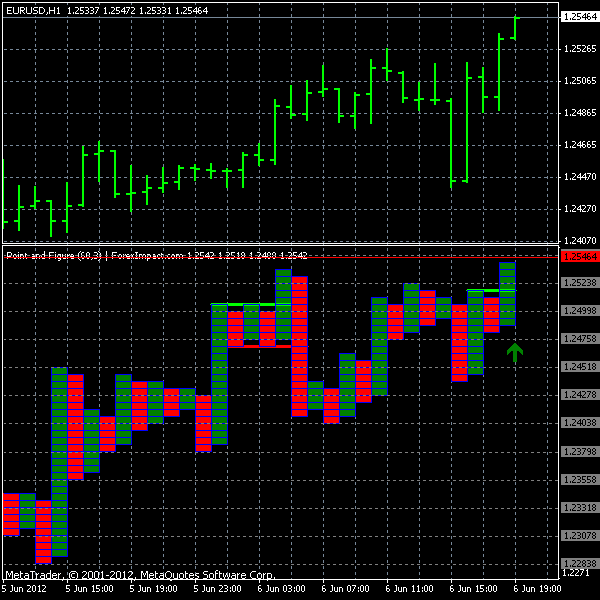
Point and Figure mod 2 offers a rather clear P&F picture for your MetaTrader charts. Box size can be set either manually or calculated by the indicator automatically using the average trading range. A trader can tune the look of the P&F chart and limit the number of original candles it uses for calculation. This can help if the indicator becomes too slow.
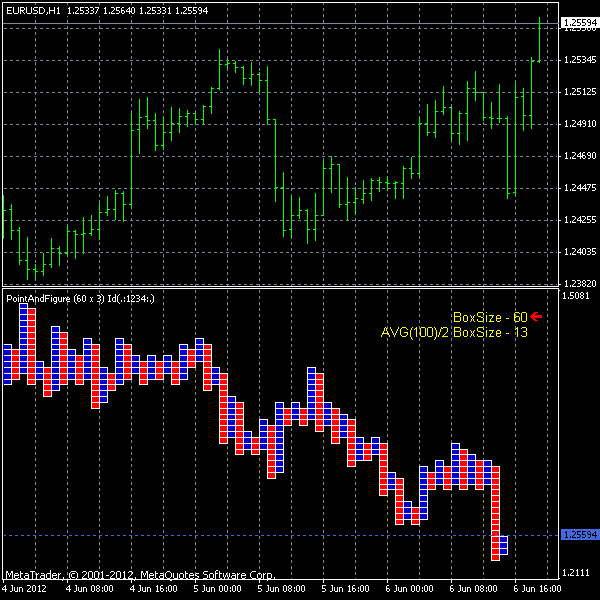
my Point and Figure — our own test
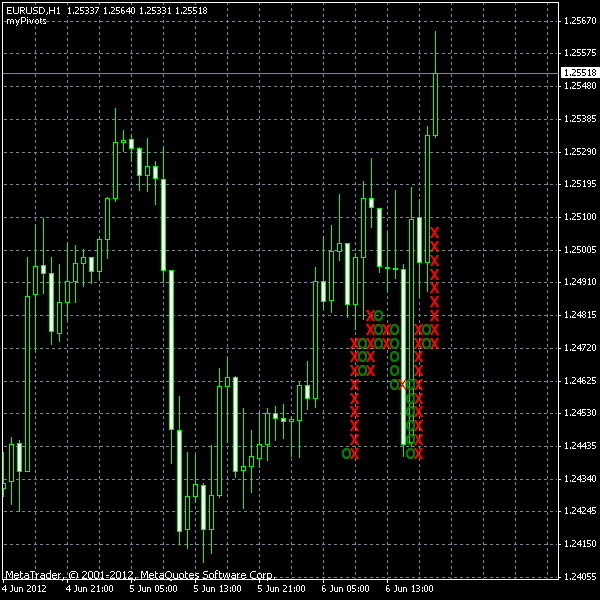
nb Point and Figure — an awesome and fully configurable P&F chart indicator. Not only it can display time information near the XO columns, it also displays projections of the P&F chart onto the main chart, showing which candles relate to which price movement. It works pretty fast and the number of bars it processes can be changed. The disadvantage is that its source code is not available for editing.
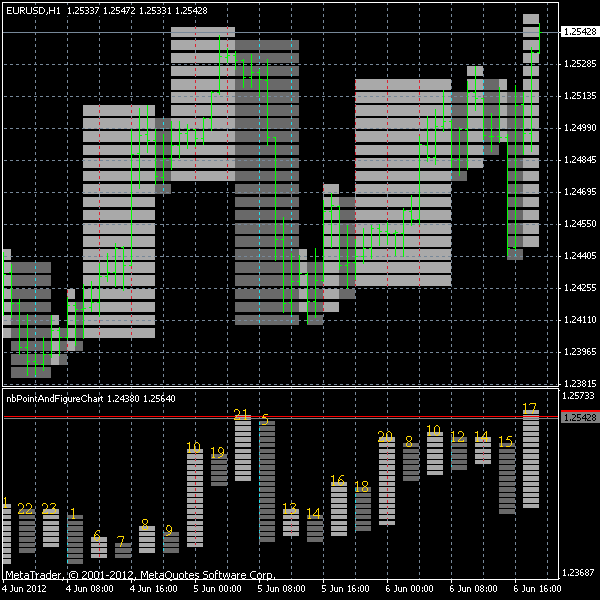
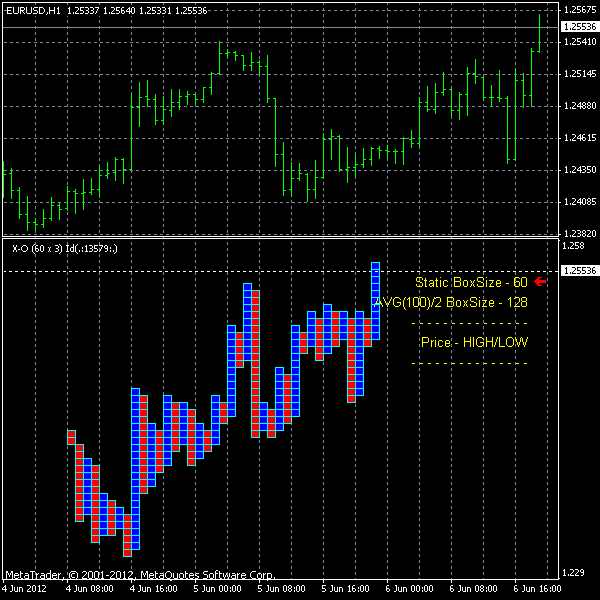
MT5
There aren't many publicly available MT5
Point-and-Figure — is our old-school P&F solution that works with the real ticks and is capable of loading tick history from your broker.
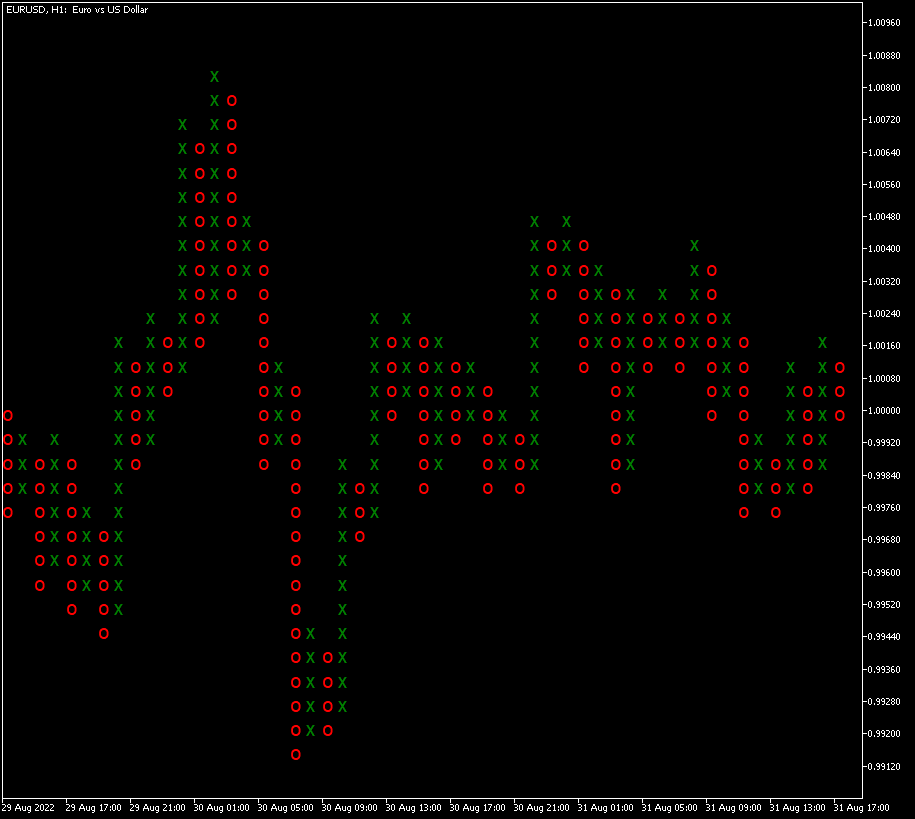
APFD — a detailedly explained
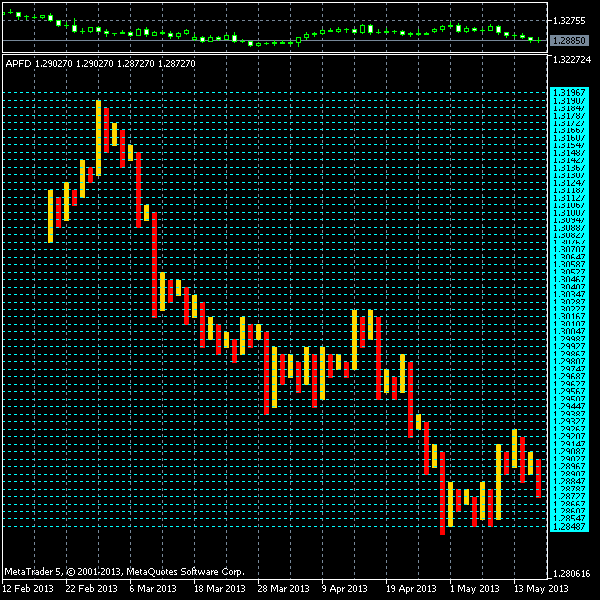
XO v01 — a P&F indicator programmed by Alexey Sergeev and Boris Gershanov from FINEXWARE Technologies GmbH. Same as APFD, it displays the chart plot using candlesticks rather than chart objects, but for some reason it also adds candlewicks to them. Also, it does not show any reference levels in its separate window, and it is really hard to tell how many rising or falling cells are inside one bar. This indicator is plotted based on the chart's timeframe it is attached to. Although it was published much earlier than APFD, I consider it somewhat inferior to the latter and list it second.
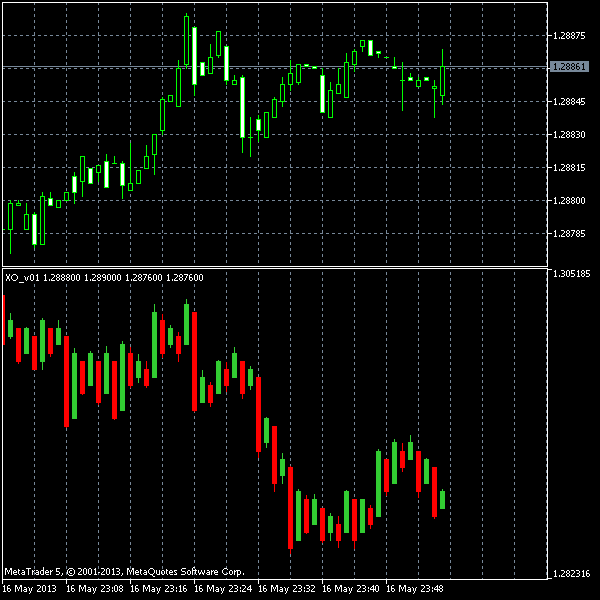
Paid options
There are also some paid P&F solutions. We have not tested any of them, but logically they should be better than the free options, at least in some minor details, but it is up to you to discover if that is so. By the way, if you have already tried any of
MultiCharts — prices start from $97 per month but a free trial version is available. It is a professional charting software package and it is
PointAndFigure.com — a specialized P&F software package with a yearly subscription fee of $357. Among its features are: automatic P&F pattern recognition, works with many data sources, automatic calculation of price objectives and P&F indicators.
Cute Point & Figure Indicator v.1.3 — a more advanced but paid ($29) version of the
Books
Free
In addition to the introductory P&F patterns
Point & Figure for Forex — an article from one of the issues of Technical Analysis of Stocks & Commodities magazine back from 2007. It offers a basic explanation of the XO charting and provides descriptions of 6 patterns.
Point and Figure Charting: A Computational Methodology and Trading Rule Performance in the S&P 500 Futures Market — a scientific research paper by John A. Anderson and Robert W. Faff. It provides a clear scientific definition of
Paid
You can also read some of the famous paid books about P&F charting and its secrets:
Point and Figure Charting by Thomas J. Dorsey — a book by the P&F guru who also used to run the PnF University at Dorsey Wright & Associates before its acquisition by NASDAQ.
The Definitive Guide to Point and Figure by Jeremy Du Plessis — a costly book praised by many traders as the bible of
Conclusion
Likely, this guide omits some of the interesting and powerful P&F charting indicators, software, or educational resources. If you know some good examples, please do not hesitate to start a discussion on this topic on our traders' forum. Please do the same if you have any questions about using
If you want to get news of the most recent updates to our guides or anything else related to Forex trading, you can subscribe to our monthly newsletter.